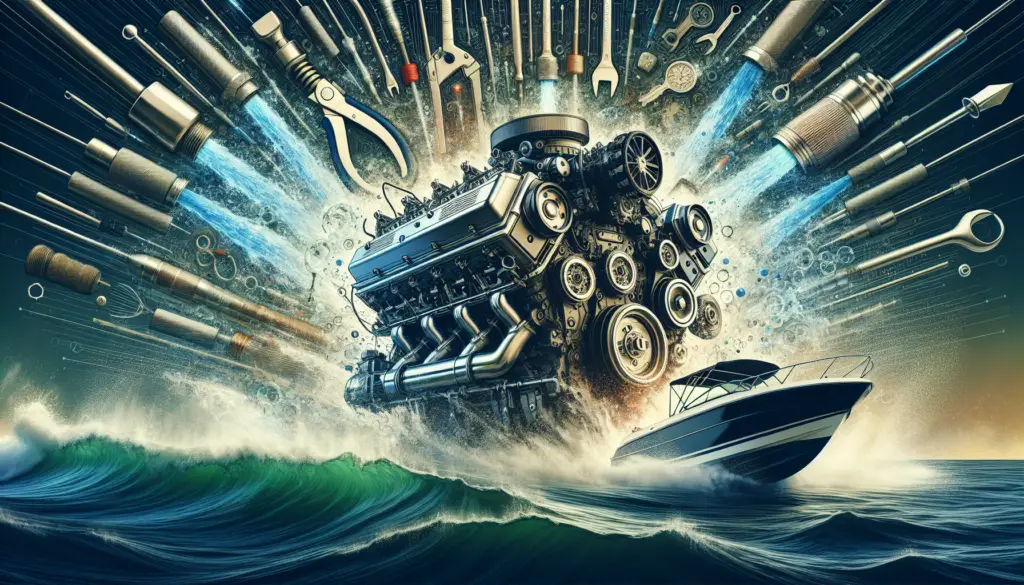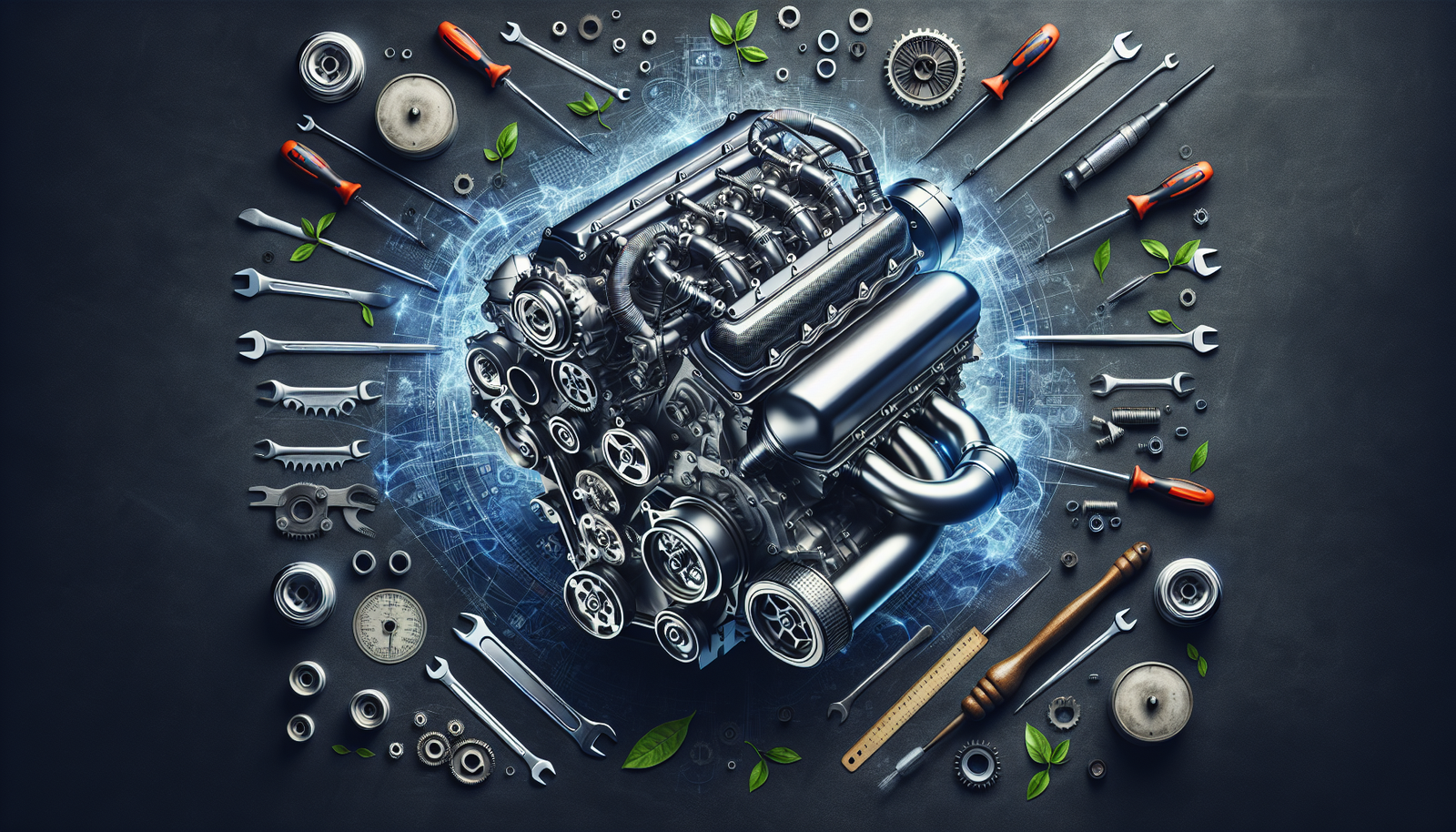So, you’re looking to give your boat engine a little more oomph, huh? Well, you’ve come to the right place! In this article, we’ll walk you through the steps of how to modify your boat engine for increased horsepower. Whether you’re an avid racer or simply want to improve the performance of your vessel, these tips and techniques will help you get the most out of your boat and make your time on the water even more exhilarating. So, grab your tools and get ready to unleash the full potential of your boat engine!

Choosing the Right Modifications
When it comes to increasing the horsepower of your boat engine, selecting the right modifications is crucial. You want to enhance the performance without compromising the reliability and safety of your vessel. There are various factors to consider before diving into any upgrades, and understanding your engine’s limits is the first step to take.
Understanding Your Engine’s Limits
Before making any modifications, it is essential to familiarize yourself with your engine’s capabilities. Every engine has its limits, and pushing it beyond those limits can lead to severe damage or even complete failure. Take the time to review your engine’s specifications, such as its maximum horsepower rating and RPM range. This information will guide you in selecting modifications that are within your engine’s capabilities.
Researching Performance Upgrades
Once you have a clear understanding of your engine’s limits, it’s time to research performance upgrades. There are numerous modifications available in the market, each offering different benefits and horsepower gains. It’s essential to research and compare these upgrades to find the ones that align with your goals and budget. Look for reputable manufacturers and read reviews from other boat owners who have installed similar modifications. This research will give you an idea of the performance gains you can expect and help you make an informed decision.
Consulting with Experts
Although researching and gathering information is a great way to start, it’s always beneficial to consult with experts in the field of boat modification. Professionals or experienced boat mechanics can provide valuable insights and recommendations based on their expertise. They can assess your engine’s condition, understand your goals, and guide you towards the most suitable modifications. By consulting with experts, you can ensure that you are making the right choices and avoid any costly mistakes.
Upgrading Air Intake System
The air intake system plays a crucial role in the performance of your boat engine. By upgrading this system, you can improve the airflow, resulting in increased horsepower and torque.
Importance of Airflow
Adequate airflow is essential for your engine to perform at its best. When your engine receives a higher volume of cooler air, it can burn fuel more efficiently, leading to improved power output. Upgrading your air intake system allows for increased airflow, which in turn optimizes combustion and enhances overall engine performance.
Replacing Factory Air Filter
One of the first modifications you can consider is replacing the factory air filter. Factory air filters are designed to be more restrictive to meet general engine requirements, which may limit the amount of air flowing into the engine. By installing a high-performance air filter, such as a foam or cotton-gauze filter, you can significantly improve air intake efficiency and enhance horsepower.
Installing Cold Air Intake Kit
Another popular modification to consider is installing a cold air intake kit. These kits relocate the air intake inlet to a cooler location, such as behind the boat dashboard or inside the boat hull. This relocation prevents the engine from drawing in hot air from the engine compartment, which can be detrimental to performance. Cold air intake kits also feature larger diameter tubing and smoother bends, allowing for better air flow and increased horsepower.

Enhancing Exhaust System
Upgrading your boat’s exhaust system is another modification that can significantly impact the engine’s horsepower and torque. It focuses on improving the flow of exhaust gases, allowing the engine to breathe more efficiently.
Benefits of Upgraded Exhaust System
An upgraded exhaust system offers multiple benefits. Firstly, it reduces the back pressure in the exhaust system, which improves the engine’s ability to expel exhaust gases. This reduction in back pressure leads to increased horsepower and torque. Secondly, an upgraded exhaust system enhances the sound of your boat. A deep growl from the engine not only sounds impressive but also adds to the overall experience of being out on the water.
Replacing Factory Exhaust Manifold
One of the key components to upgrade in the exhaust system is the factory exhaust manifold. Factory manifolds often have design limitations that restrict the flow of exhaust gases. By replacing it with an aftermarket performance manifold, you can achieve better exhaust flow, which increases horsepower and torque. These aftermarket manifolds are usually designed with larger ports and smoother bends for optimized exhaust flow.
Installing High-Flow Catalytic Converter
For boaters who want to maintain environmental friendliness while gaining more horsepower, installing a high-flow catalytic converter is an excellent choice. This modification ensures that the exhaust gases are properly treated without compromising the engine’s performance. High-flow catalytic converters allow for better exhaust gas flow, reducing back pressure and maximizing power output.
Tuning Fuel System
The fuel system of your boat engine is responsible for delivering the right amount of fuel at the correct time. By optimizing this system, you can ensure proper fuel delivery, resulting in increased horsepower and improved engine response.
Importance of Proper Fuel Delivery
Proper fuel delivery is crucial for engine performance. The fuel system needs to deliver the right amount of fuel to keep the air-fuel mixture in the combustion chamber optimal. If the fuel delivery system is insufficient, it can lead to a lean mixture, which can cause damage to the engine. On the other hand, an overly rich mixture can result in poor combustion, leading to decreased power output. Tuning the fuel system ensures that the engine receives the right fuel-air mixture for optimum performance.
Installing High-Flow Fuel Injectors
One way to optimize your fuel system is by installing high-flow fuel injectors. These injectors allow for a larger volume of fuel to be delivered into the combustion chamber, promoting better fuel atomization and combustion. Upgrading to high-flow fuel injectors ensures that the engine receives the necessary amount of fuel to support increased horsepower and torque.
Upgrading Fuel Pump
Another component of the fuel system that can be upgraded is the fuel pump. An upgraded fuel pump ensures that the engine receives a consistent and adequate fuel supply. With higher horsepower modifications, the demand for fuel increases, and a stock fuel pump may struggle to keep up. Upgrading to a performance fuel pump ensures that fuel delivery remains optimal, even under increased loads, maximizing engine performance.

Optimizing Ignition System
The ignition system is responsible for igniting the air-fuel mixture within the combustion chamber. Optimizing this system enhances spark performance and ensures proper ignition timing, resulting in increased horsepower and improved overall engine performance.
Improving Spark Performance
Improving spark performance is crucial for efficient combustion. A stronger and more reliable spark ignites the air-fuel mixture more effectively, leading to better combustion and increased power output. Upgrading your ignition system components can help achieve improved spark performance.
Installing Performance Spark Plugs
One of the easiest and most effective ways to enhance spark performance is by installing performance spark plugs. Performance spark plugs provide a stronger spark and have better heat dissipation capabilities compared to stock plugs. These plugs are also available in various heat ranges, allowing you to select the most suitable option for your engine’s needs.
Upgrading Ignition Coils
Upgrading your ignition coils is another modification that can significantly impact spark performance. Quality aftermarket ignition coils provide a more powerful spark, ensuring complete combustion of the air-fuel mixture. By upgrading to performance ignition coils, you can achieve more efficient combustion, resulting in increased horsepower and improved engine response.
Increasing Compression Ratio
Increasing the compression ratio of your boat engine is a modification that can yield significant horsepower gains. This modification focuses on raising the pressure within the combustion chamber, enhancing combustion efficiency and overall performance.
Understanding Compression Ratio
The compression ratio is the ratio of the cylinder’s total volume when the piston is at the bottom of its stroke to the total volume when the piston is at the top of its stroke. Increasing the compression ratio means reducing the volume at the top of the stroke, resulting in higher pressure and a stronger combustion event. This increase in pressure translates into increased power output.
Replacing Pistons and Cylinder Heads
To increase the compression ratio, you will need to replace the stock pistons and cylinder heads with components that offer a higher compression ratio. These aftermarket pistons and cylinder heads have different designs and specifications, allowing for a more efficient compression process. It’s crucial to ensure that the new components are compatible with your engine and that the installation is performed correctly to avoid any engine damage.
Using Thicker Head Gaskets
Another method to increase the compression ratio without changing pistons and cylinder heads is by using thicker head gaskets. Head gaskets with increased thickness reduce the volume in the combustion chamber, effectively raising the compression ratio. This modification is less drastic than replacing pistons and cylinder heads but can still provide noticeable horsepower gains.

Adding a Supercharger or Turbocharger
For boaters looking for substantial horsepower gains, adding a supercharger or turbocharger to their engine is a popular choice. These forced induction systems increase the amount of air entering the engine, resulting in significant power increases.
Choosing the Right Forced Induction System
Selecting the appropriate forced induction system depends on various factors, including the boat size, engine specifications, and personal preferences. Superchargers use a belt-driven compressor to force more air into the engine, while turbochargers use exhaust gases to spin a turbine that compresses the air. Both systems have their advantages and disadvantages, and it’s crucial to consult with experts to determine the best option for your specific needs.
Understanding the Working Principles
Superchargers and turbochargers work by compressing the air entering the engine, allowing for more oxygen to be available during combustion. This increase in oxygen enables the engine to burn more fuel, resulting in increased horsepower and torque. Understanding how these systems work and their impact on your engine’s performance is essential for a successful installation and optimization.
Considering Intercooler Installation
When adding a supercharger or turbocharger, it’s essential to consider installing an intercooler. These cooling devices help reduce the temperature of the compressed air before it enters the engine. Cooler air is denser, allowing for even more oxygen for combustion. With the intercooler’s installation, you can enhance the efficiency and reliability of your forced induction system, maximizing horsepower gains and preventing potential issues related to heat.
Upgrading Engine Cooling System
Ensuring that your boat engine stays cool is vital for maintaining optimal performance and preventing overheating. Upgrading the engine cooling system can help dissipate heat more effectively and keep the engine operating at desirable temperatures.
Preventing Overheating Issues
Overheating can have severe consequences on your boat engine’s performance and longevity. It can lead to increased wear and tear, reduced power output, and, in extreme cases, engine failure. Upgrading your engine cooling system helps prevent overheating issues, allowing the engine to operate within optimal temperature ranges.
Installing High-Flow Water Pump
Upgrading to a high-flow water pump is one modification that can significantly improve the engine’s cooling efficiency. High-flow water pumps circulate coolant at a faster rate, ensuring that the engine remains at a consistent temperature. These pumps are designed to move a larger volume of coolant, leading to better heat dissipation and preventing hotspots within the engine.
Upgrading Radiator and Fans
Another essential component of the engine cooling system to consider upgrading is the radiator and fans. Performance radiators allow for better heat exchange, efficiently dissipating heat from the engine. Upgrading to a larger radiator with improved cooling capacity can prevent overheating issues, especially when operating under heavy loads or in extreme environmental conditions. Additionally, installing high-performance fans that offer enhanced airflow can further improve the cooling system’s effectiveness.

Optimizing Engine Management System
The engine management system, often controlled by the Engine Control Unit (ECU), plays a crucial role in controlling various engine parameters. Optimizing this system through tuning or the use of performance chips can unlock additional horsepower and improve overall engine performance.
Benefits of Engine Control Unit (ECU) Tuning
ECU tuning involves modifying the software that controls the engine’s parameters, such as fuel delivery, ignition timing, and turbocharger boost levels. By customizing these parameters, you can optimize the engine’s performance based on your boat’s specific needs. ECU tuning can lead to increased horsepower, improved throttle response, and better fuel efficiency.
Choosing the Right Performance Chip
Performance chips are an alternative to ECU tuning and offer an easier installation process. These chips, also known as power programmers, adjust the factory settings of the engine management system to optimize performance. When choosing a performance chip, consider compatibility with your engine’s make and model and look for features such as adjustable settings and real-time monitoring capabilities.
Considering Standalone Engine Management System
For boaters looking for complete control and customization of their engine’s performance, a standalone engine management system may be the ideal solution. Standalone systems provide the ability to tune and adjust various engine parameters independently from the factory ECU. However, choosing a standalone engine management system requires expert knowledge and installation, as it involves significant rewiring and programming.
Improving Propeller Performance
The propeller is a critical component of your boat’s performance, and improving its design and specifications can enhance overall horsepower and efficiency.
Understanding Propeller Design
To improve propeller performance, it’s important to understand the key elements of propeller design. Factors such as blade shape, pitch, and diameter influence the propeller’s efficiency and the boat’s ability to reach higher speeds. Propeller design is a complex topic, and consulting with experts or experienced boat propeller technicians can help you choose the right propeller for your engine and vessel.
Choosing the Right Propeller Pitch and Diameter
Selecting the correct propeller pitch and diameter is crucial for achieving optimal performance. Pitch refers to the distance a propeller would travel in one complete revolution, while diameter represents the width of the propeller. The right combination of pitch and diameter ensures that the engine operates within its optimal RPM range and maximizes power output. Consider factors such as boat weight, desired speed, and engine specifications when choosing the pitch and diameter for your propeller.
Considering Stainless Steel Propellers
Upgrading to stainless steel propellers is another modification that can improve performance. Stainless steel propellers offer enhanced durability, efficiency, and strength compared to aluminum propellers. They are less prone to bending or flexing, allowing for better overall performance and power transfer. When considering stainless steel propellers, consult with experts to ensure the right propeller design for your engine and boat specifications.
By following these comprehensive guidelines, you can successfully modify your boat engine for increased horsepower. Remember to thoroughly research and consult with experts to ensure the modifications you choose are appropriate for your engine and vessel. Enhancing your boat’s performance can provide a thrilling experience on the water while maintaining the necessary reliability and safety. So, go ahead and make those modifications, and enjoy the newfound power and excitement you’ll experience with your upgraded boat engine.


[…] extra power on the water? One of the best ways to achieve this is by increasing its horsepower. By upgrading your boat’s engine with performance parts specifically designed to boost horsepower, you can experience a significant improvement in speed […]
[…] is increasing horsepower. This enhancement allows your boat to reach higher speeds and improve overall performance. By upgrading certain components of your engine, such as the camshaft, cylinder heads, and exhaust […]